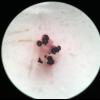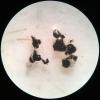
10-09-2025 23:53
 Marcel Heyligen
Marcel Heyligen
Found on Robinia pseudoacasia together with Diapor

11-09-2025 16:57
Our revision of Marthamycetales (Leotiomycetes) is

10-09-2025 17:18
 Blasco Rafael
Blasco Rafael
Hola, encontre este estiercol de vaca estos apotec

02-09-2025 11:34
Thomas Læssøehttps://svampe.databasen.org/observations/10527903

03-09-2025 21:59
Philippe PELLICIERLa Léchère, Col de la Madeleine, alt 1970m, au s

07-09-2025 11:34
 Zuzana Sochorová (Egertová)
Zuzana Sochorová (Egertová)
Hello,I have identified this fungus as Hymenoscyph
Byssosphaeria
Ethan Crenson,
26-10-2019 05:44
I recently found what I think is Byssosphaeria sp. near New York City. I frequently collect B. rhodomphala in many NYC parks, but this collection seems a different to me. For one thing the red pigments around the ostiole are not pronounced--this is a fairly large collection and I usually see some red somewhere. The spores seem quite a bit darker brown with the ends of the cells quite dark brown. I see a sheath around the spores and/or hyaline spore appendages at the ends of the spores. Spores measure 17.5-23 x 5-6µm. Asci about 109 x 11µm. Perhaps I simply collected over-mature fruiting bodies of B. rhodomphala that lost the red pigmentation around the ostioles. But I have been going through Barr's key in her Melanommatales paper (key pictured) and puzzling over other possibilities. Does anyone have any input they can provide? Thank you in advance.
Ethan
Alain GARDIENNET,
26-10-2019 23:08
Re : Byssosphaeria
Hi Ethan,
You have analyzed the situation very well
In addition, maybe you should also compare it to B. xestothele ?
I attach a small synthesis work that I had done about the existing Byssosphaeria.
If you don't have the Mexican paper, I can send it to you.
Best wishes,
Alain
Alain GARDIENNET,
26-10-2019 23:11
Ethan Crenson,
28-10-2019 20:30
Re : Byssosphaeria
Alain,
Thank you so much for your synthesis and the paper! I had no idea about the vinaceous pigments in KOH from B. rhodomphala. I tested a previous collection of B. rhodomphala and found the dark red pigments. Then I tested the collection from this post and found no pigments. So my suspicion that this is not B. rhodomphala was correct. (photos attached here.)
Perhaps my first photo of the apothecia was misleading, but I see no red pigmentation around the ostioles--they look dull-gray to me. With the Chacón-Zapata key this leads me to a dead end... D. diffusa spores are too small and B. jamaicana too large. With the Barr key I get stuck as well. The spores of my collection have mostly obtuse ends when less mature. In the mature spores with the darker apices, they seem more acute. I have seen no examples of ascospores that are 3-septate in any of my mounts. Perhaps I need to explore this further.
Thank you again. I can send you an english translation of the Chacón-Zapata paper that I made if it would be useful to you.
Ethan


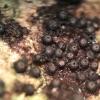
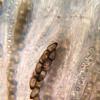
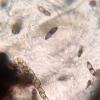
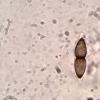

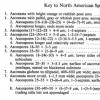
 Byssosphaeria-synthese-0001.xls
Byssosphaeria-synthese-0001.xls